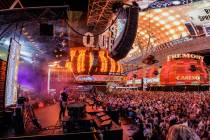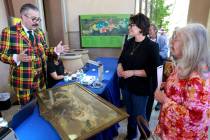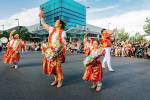‘A World of Holiday Traditions’ explores fetes from around the globe
In spite of — or, come to think of it, maybe because of — the bleakness of winter, the season turns out to be a popular time for celebration.
Christmas, always. Hanukkah, often. And, then, all sorts of other celebrations around the world, all of which seek to wrest a bit of festive celebration from the cold and dark of winter.
Southern Nevadans can learn about how the rest of the world celebrates wintertime holidays at an exhibit that will run through Jan. 4 at the Las Vegas Natural History Museum, 900 Las Vegas Blvd. North.
The exhibit, along the museum’s Grand Hallway and in its Wildlife Gallery, features displays devoted to the wintertime holiday celebrations of more than 20 cultures around the world.
In a Hanukkah display, visitors learn about the Jewish festival of lights and, in a nearby display, Islamic seasonal traditions. Along the hallway are displays about Wiccan winter celebrations, Buddhist celebrations and observances and celebrations from an atlas of countries that includes Russia, Norway, Greece, Scotland and Thailand.
Represented are a widely diverse collection of wintertime traditions. Intriguing is how so many cultures share a theme of seeking light and solace during the most sunlight-bereft season of the year.
Marilyn Gillespie, the museum’s executive director, says the exhibit — which the museum is mounting as part of the December to Remember celebration along downtown Las Vegas’ Cultural Corridor — is an annual offering that has grown each year.
And, as it turns out, it’s a perfect exhibit for Gillespie to oversee, and not just for professional reasons.
“I’m a little bit of a Christmas decorating fanatic,” she says, smiling. “I am a crazy person. I have a shed just with my Christmas decorations.”
Given that, it’s not surprising that Gillespie always is interested in learning about other cultures’ Christmas celebrations. Take, for instance, the countertop model of a Greek sailing vessel flying tiny flags that’s dry-docked in her office.
During a trip to Greece, she says, “I kept asking locals, ‘What do you do for your Christmas traditions that might be different than what I do in America?’ ”
Gillespie found that, because boating and shipping are “such a big part of their life, they decorate their boats with flags” at Christmas.
“Then, something else they do is, they have a tradition that the children go around and have, like, little musical triangles, and it’s kind of, in my mind, like trick or treat. They go from house to house, and people would give them candies or pennies.”
While the exhibit does incorporate Christmas traditions from around the world, it goes beyond Christmas,” Gillespie adds.
“One thing we realize is, I may be celebrating Christmas, but you may not,” she says. “But almost every culture celebrates something in wintertime. So we’re really just kind of explaining all of these wonderful traditions and celebrations from around the world.”
Cultural organizations from throughout the community — including the St. Andrews Society of Southern Nevada for Scotland’s display, the local Sons of Norway’s Vegas Viking Lodge for Norway’s display, and The Temple of Goddess Spirituality in Indian Springs for the Wicca display — supplied items and helped to create the exhibits.
“Some of the things we’ve put together from our research,” Gillespie says. “But most of it is things that we’ve asked our community to come in and help us with.”
It’s interesting how so many traditions are similar in so many ways, Gillespie says. Equally interesting is the history that lies behind many of the wintertime traditions that we’ve now come to take for granted.
Consider, for instance, the Christmas tree. In ancient times, Gillespie explains, people “looked outside at the snow, and everything was dead, but there would be these trees that didn’t die. And they were revered, because everything else is dead and, yet, these trees didn’t die.”
People began to bring the evergreens, or pieces of the evergreens, into their homes because they were special, she says. “That was really the beginning of our Christmas tree tradition.”
Also intriguing is how traditions can seep across cultures. For example, Gillespie says, “a lot of things that have been incorporated into our Christian tradition (of Christmas) were actually used by the pagans before Christianity came along.”
“A lot of people may not want to hear that,” she adds, “but it’s true.”
As part of the exhibit, a cultural fashion show will take place at 11 a.m. Saturday featuring models wearing the traditional costumes of almost a dozen nations.
The celebration also will include programs at the museum throughout December devoted to individual cultures and celebrations. The calendar includes programs about Polynesian culture (1 p.m. Monday), Scotland (1 p.m. Dec. 15), the Winter Solstice (11 a.m. and 1 p.m. Dec. 21) and Kwanzaa (11 a.m. and 1 p.m. Dec. 28 and 1 p.m. Dec. 29). For more information, visit http://lvnhm.org/december-to-remember. There’s no additional charge for the holiday programming beyond the normal museum admission fee.
Also this year, guests will get the opportunity to write about their own special family Christmas or wintertime traditions and share them on a community billboard.
For example, Gillespie says, “my sister and her boys … every Christmas morning they make doughnuts and decorate doughnuts, and it’s not Christmas to them unless they do that.”
This particular season also brings the Las Vegas Natural History Museum a rare gift: accreditation in August by the America Alliance of Museums, which, Gillespie says, is held by only 6 percent of museums in the United States and followed a three-year-long accreditation process.
Ultimately, Gillespie says, the goal of the Las Vegas Natural History Museum’s December to Remember exhibition is not only educating visitors about other cultures’ wintertime traditions, but also fostering understanding through the realization that, but for a few cultural variations, “we’re all pretty much the same.”
Above all, the exhibition is a fun tour through the wintertime holiday season. Take, for instance, inclusion in the exhibition of an aluminum Christmas tree.
And what ancient culture might have used that? Gillespie laughs.
“Retro Americans,” she answers, during “the ’50s or the ’60s.”
“But this is part of our Americana past. That’s the way we used to celebrate,” Gillespie says.
“We have an original one that one of our volunteers donated, and she even had her original rotating (colors) light.”
Contact reporter John Przybys at jprzybys@review journal.com or 702-383-0280.
PREVIEW
What: "A World of Holiday Traditions"
When: 9 a.m. to 4 p.m. daily (through Jan. 4)
Where: Las Vegas Natural History Museum, 900 Las Vegas Blvd. North.
Admission: $10 general admission; $8 seniors, military and children 12 and older; $5 children 3 to 11; children 2 and younger free (702-384-3466)































